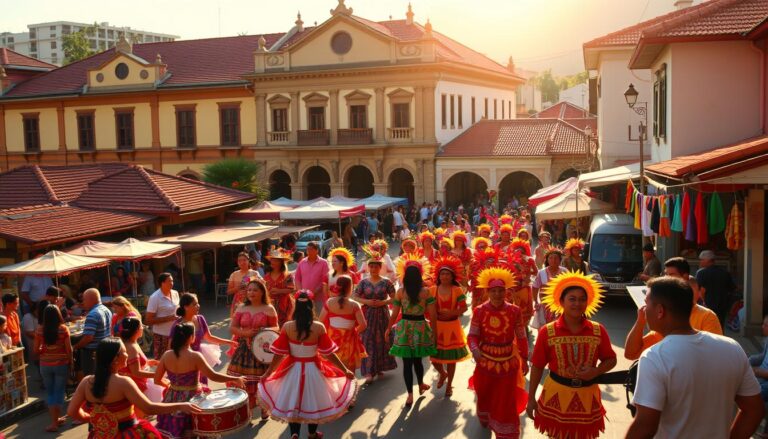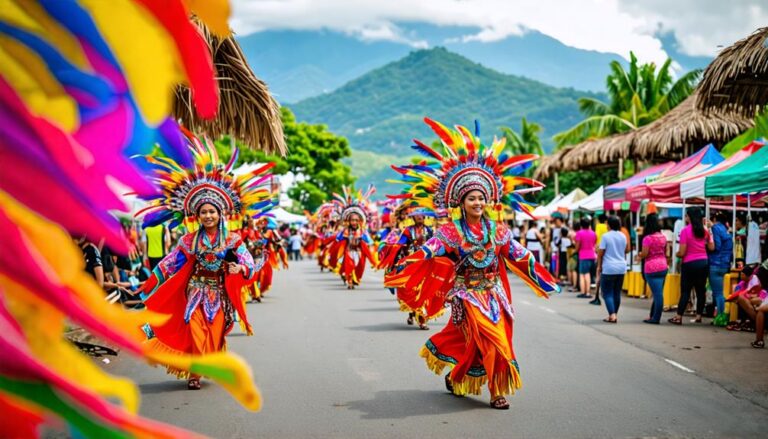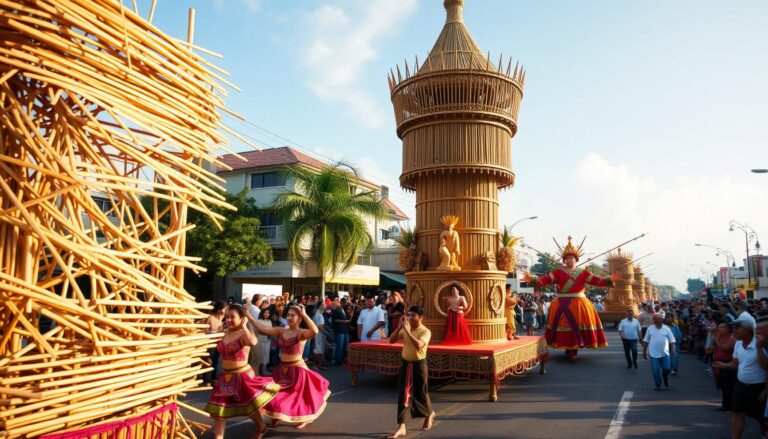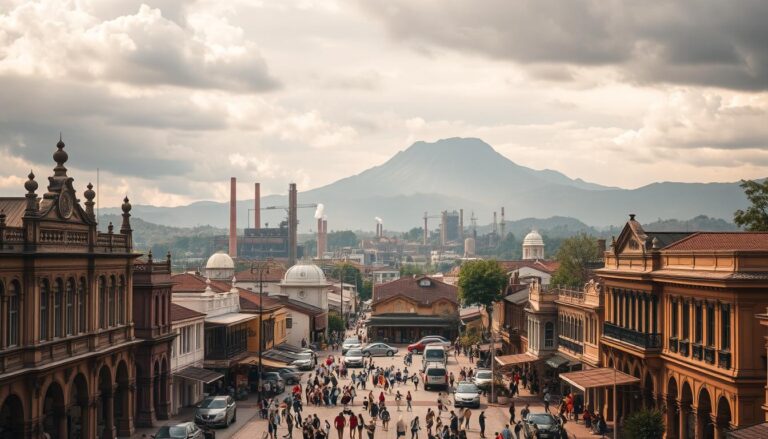Feast of the Black Nazarene Philippines
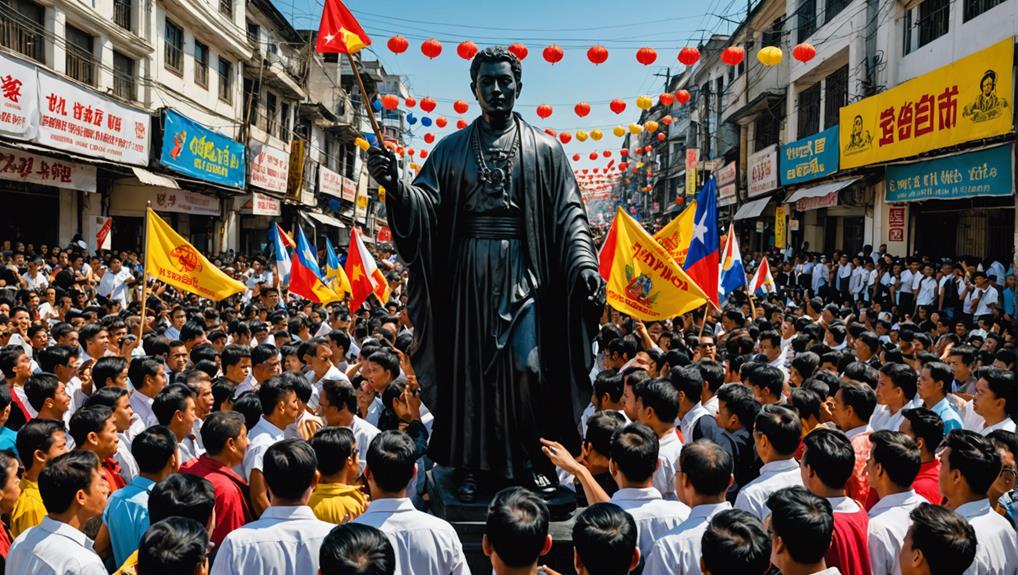
The Feast of the Black Nazarene in the Philippines is a profound display of faith and devotion, occurring annually on January 9th. You'll witness thousands of devotees walking barefoot through Manila, emulating Christ's suffering and venerating this sacred statue. Starting in late December, activities like the Pahalík and night vigils lead up to the grand Traslación. This staggering event reflects Filipino spirituality and cultural life, deeply impacting all participants. Travelers should prepare for the intense crowd and respect local customs. With so much history and spiritual fervor, there's an abundance of insight and experience available for you.
Key Takeaways
- The Feast of the Black Nazarene is a major religious event held annually on January 9 in Quiapo, Manila.
- It features the Traslación, a procession commemorating the transfer of the Black Nazarene statue to Quiapo Church in 1787.
- Devotees participate in various rituals, including walking barefoot and kissing the statue, to emulate Christ's suffering and seek blessings.
- The Black Nazarene is revered for its supposed miraculous powers, especially in healing and personal petitions.
- Safety measures include crowd control strategies, emergency preparedness, and adherence to specific event regulations to ensure participant security.
Historical Origins
The Feast of the Black Nazarene began when the revered statue was first brought to Manila from Mexico in 1606 by Augustinian Recollect missionaries. This symbolic transfer marked the beginning of a profound tradition that has grown in historical significance over the centuries. Initially, the icon was enshrined in several churches, moving from San Juan Bautista in Bagumbayan to the Recollect Church of San Nicolás de Tolentino in Intramuros, before settling in Quiapo Church in 1787.
This relocation isn't just a logistical change; it's embedded deeply in the religious roots of the Filipino Catholic community. The journey of the Black Nazarene mirrors the passion of Christ, which is central to the devotional practices surrounding this icon. The traditional customs that have developed around this event, such as the kissing of the statue, reflect the personal and communal piety that characterizes the feast.
The iconic procession, known as the Traslación, commemorates this historic move and has become a massive event in its own right, drawing millions annually. It's not only a display of faith but also a reenactment of the endurance and suffering of Christ, which resonates deeply with many.
Understanding the historical origins of this feast helps you appreciate not just the scale of the event today, but also its deep spiritual and cultural layers. It's a vivid example of how history and faith intertwine, creating traditions that endure and evolve with each passing year.
Feast Activities
During the Feast of the Black Nazarene, activities kick off in late December, culminating with the grand Traslación on January 9. This period is rich with spiritual observances that blend procession traditions with religious customs, offering you a profound way to connect with your faith.
The activities leading up to the Traslación include various iconic rituals that are deeply embedded in the culture of the Filipino Catholic community. You'll witness the devotional practices that aren't just acts of faith but also expressions of communal identity and historical continuity. Here's what you can expect:
- Thanksgiving Procession: Held on December 31, this procession sets the tone for the forthcoming religious fervor. It's a time for gratitude and reflection, preparing you spiritually for the new year.
- Pahalík: Occurring just before the Traslación, devotees gather to kiss or touch the revered image of the Black Nazarene. It's a poignant moment of personal devotion and a communal sharing in the suffering and perseverance of Christ.
- Night Vigils and Hourly Masses: These spiritual observances happen throughout the night leading up to January 9. They're times for prayer, singing, and preaching, providing you with spiritual sustenance for the long walk during the Traslación.
Engaging in these activities, you become part of a living tradition that stretches back centuries. Each step, chant, and prayer during these days not only honors the sacred image but also fortifies your own spiritual journey.
Devotee Practices
Devotees engage in various practices to express their reverence and seek blessings during the Feast of the Black Nazarene. You'll find yourself immersed in a sea of maroon and yellow, as millions of followers, fueled by religious fervor, participate in the celebrated procession traditions. Walking barefoot, you emulate the suffering of Christ, a poignant symbol of penance and devotion.
Among the spiritual customs, the healing rituals stand out strikingly. It's common to see devotees tossing handkerchiefs to the Hijos del Nazareno, who rub them on the statue, believed to imbue them with healing powers. This act of faith, seeking physical and spiritual healing, underscores the deep devotional practices that mark this feast.
As you navigate through the crowd, the intensity of the collective prayer and singing encapsulates the essence of the event. This isn't just a religious ceremony; it's a profound communal experience where every shout of 'Viva!' and every strained pull of the carriage ropes binds you to the soul of Filipino spirituality.
The participation in these devotional practices isn't just about seeking personal blessings but also about a shared expression of faith and identity. Each step you take, each prayer you utter adds to the rich tapestry of spiritual customs that define the Feast of the Black Nazarene. Here, in the heart of Manila, amidst the chaos and fervor, you witness a living tradition, pulsating with the heartbeats of millions, each devotee a proof of enduring faith and devotion.
Cultural Significance
Reflecting on these practices, you can see how the Feast of the Black Nazarene stands as a profound cultural beacon in Filipino society. This annual event not only brings together millions in a shared expression of faith but also highlights the unique blend of religious and cultural identity of the Philippines. Here's how the feast transcends mere tradition to impact deeply on community life:
- Miraculous Beliefs and Healing Powers
- The Black Nazarene is believed to possess miraculous healing powers, drawing countless devotees who seek physical and spiritual relief. This belief fuels a religious frenzy each year, as people from all walks of life gather with the hope of touching the statue or its carriage, believing such contact will bring healing and good fortune.
- Devotional Practices
- The feast is characterized by intense devotional practices. You might see participants walking barefoot as a form of penance, mirroring Jesus' suffering. The 'Pahalik' ritual, where devotees kiss the statue, and the 'Traslación', a chaotic yet fervent procession, are central events, showcasing the depth of the devotees' faith and dedication.
- Participant Roles
- The roles you might take on during the feast vary widely, highlighting a community united in its diversity. From the 'Hijos del Nazareno', who manage the procession, to ordinary devotees pulling the rope and those attending out of cultural curiosity, each participant contributes to the dynamism and vibrancy of the event.
Through these practices, the Feast of the Black Nazarene encapsulates a rich tapestry of Filipino cultural and spiritual life, leaving an indelible mark on all who participate.
Logistics and Travel

If you're planning to attend the Feast of the Black Nazarene, booking your flight to Ninoy Aquino International Airport is an essential first step. Once you've landed, you'll find a variety of transportation options to take you directly into the heart of Manila where the event takes place. Consider renting a car, taking a taxi, or hopping on one of the many buses and jeepneys that are rerouted to accommodate the influx of devotees.
Navigating to the Quiapo Church, the epicenter of the festivities, is easier if you familiarize yourself with the pilgrimage routes beforehand. These routes are often crowded and busy, so knowing your way can save you a great deal of time. For accommodation suggestions, look for hotels or guesthouses in the Quiapo area or nearby districts like Binondo or Malate. Booking early is advisable as places fill up quickly due to the high number of attendees.
While you're in Manila, don't miss out on cultural immersion opportunities. Explore the rich history and vibrant culture of the city by visiting other historical sites and museums. Engage with the locals, participate in communal activities, and embrace the chance to learn more about Filipino traditions.
Additionally, take the time to explore local cuisine. Manila offers a wide array of food choices that reflect its diverse cultural heritage. From street food vendors selling traditional Filipino snacks to fine dining restaurants offering gourmet dishes, there's something to satisfy every palate.
Safety and Regulations
You should be aware of the stringent safety measures and regulations in place during the Feast of the Black Nazarene to guarantee a safe experience for all participants. Every year, millions of devotees participate in this deeply significant event, and ensuring everyone's safety is a top priority.
Here's what you need to know about the safety protocols and guidelines:
- Crowd Management:
- Authorities implement detailed crowd control strategies to manage the massive influx of participants. Corridors and barriers are strategically placed to regulate the movement of the crowd, minimizing the risk of stampedes and injuries.
- Event Regulations:
- Specific rules are enforced to maintain order during the event. For example, alcohol, sharp objects, and oversized backpacks are prohibited within the procession area. Additionally, wearing proper attire and following the guidance of event marshals are mandatory to ensure a respectful and safe environment.
- Emergency Preparedness:
- Emergency response teams are stationed at various points along the procession route. These include medical personnel, fire services, and police forces ready to handle any situation. Furthermore, multiple first aid stations and hydration points are available to assist attendees who might face health issues due to the physical demands of the procession.
Understanding and adhering to these safety measures, security protocols, and event regulations not only guarantees your safety but also respects the sanctity of the Feast of the Black Nazarene. So, make sure you're prepared, stay aware of your surroundings, and follow the rules set by the organizers for a safe and spiritually fulfilling experience.
Frequently Asked Questions
What Is the Symbolism Behind the Black Nazarene's Dark Color?
The Black Nazarene's dark color symbolizes Christ's suffering and humanity. It reflects historical origins, holds cultural significance, influences religious interpretation, and guides devotional practices, enhancing its artistic representation in Filipino Catholicism.
How Do Local Businesses Adapt During the Feast of the Black Nazarene?
You'll find local businesses thriving by offering specialty products and cultural merchandise. Many extend hours, while street vendors pop up everywhere. They also ramp up security measures to handle the increased foot traffic.
Are There Specific Prayers or Hymns Sung Uniquely at This Feast?
You'll find specific prayers and hymns sung uniquely at major religious feasts, including devotional songs deeply rooted in prayer traditions and hymnal origins that enhance pilgrim participation and create powerful chant effects.
How Do Non-Catholic Observers Participate in or View the Event?
As a non-Catholic observer, you'll experience cultural curiosity, uphold observer etiquette, and engage in religious tourism. Guarantee spectator safety and foster positive community interactions during such significant events.
What Environmental Impacts Does the Feast Have on Quiapo and Surrounding Areas?
You'll notice waste management challenges, air quality decline, water pollution issues, noise pollution effects, and ecological footprint concerns impacting Quiapo and surrounding areas during large gatherings.
Conclusion
As you plan your journey to the Feast of the Black Nazarene, remember that you're stepping into a powerful tradition. Dress comfortably, stay hydrated, and respect the local customs.
Whether you're joining to deepen your faith or to witness this unique cultural spectacle, you'll find yourself moved by the sheer devotion and communal spirit.
Be prepared for a profound experience, where faith, tradition, and resilience blend into an unforgettable pilgrimage.
Safe travels and embrace the spirit of 'Viva Señor!'



